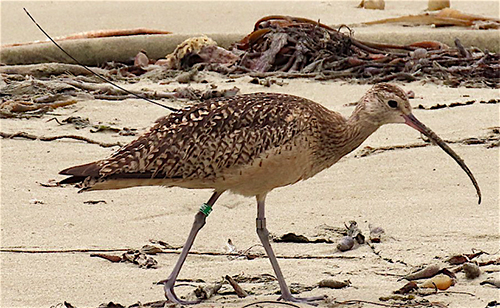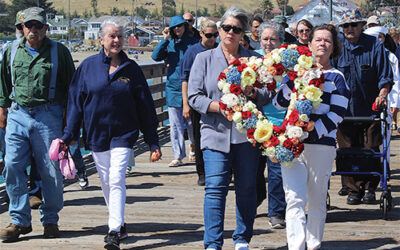A Long-billed Curlew named Dozer was recently spotted mingling with other curlews on Morro Strand Beach. Dozer, along with another curlew named Neil, were banded by the Intermountain Bird Observatory of Boise, Idaho and both wound up in Morro Bay. Photo by Petra Schaaf
Morro Bay can sometimes get rather odd visitors and the recent encounter of a local bird watcher who spied two, banded, long-billed curlews on Morro Strand Beach is a timely tale as well.
Los Osos’ Petra Schaaf told Estero Bay News of an encounter she had on Father’s Day, Sunday, June 21. And with Morro Coast Audubon Society organizing a virtual lecture event on Aug 17 with Heather Hayes, a research biologist and the Community Science Coordinator for the Intermountain Bird Observatory in Boise, Idaho, the timing couldn’t be better.
“The MCAS presentation,” Schaaf said, “was prompted by the fact that two, Long-billed Curlews, banded in Idaho in May, showed up in Morro Bay in June.”
She was walking the Strand and noticed something odd about a particular bird.
“At first I only saw this odd thing sticking up on the bird’s back,” Schaaf said. “I thought it was something detrimental to the bird. They do pick up the weirdest things. When I saw the bands, though, I knew it was a tagged bird.” The bird’s leg sported a bright green band and was obviously part of some study.
“I took a long video of the legs to get a good view of the band numbers,” she explained, “always important when reporting sightings of banded birds. After some Googling, I discovered the existence of the Intermountain Bird Observatory and reported my sighting. I learned that I had spotted Dozer!”
The folks at IBO were excited because Dozer had been banded along with another curlew named “Neil” as part of the “Curlew Project” study, and finding them in Morro Bay was a first.
The birds “are the very first curlews from any of their breeding research study sites to migrate directly to Coastal California to overwinter. Also, it is rare that they get photos/videos of tagged birds, let alone photos good enough to read a leg band number.”
Schaaf discovered that Dozer, “was banded and fitted with a satellite transmitter in May 2020 by the Intermountain Bird Observatory at his breeding grounds in Indian Valley in the West Central Mountains of Idaho. He migrated out about June 17.”
That long, spiky thing sticking out of Dozer’s back was a GPS device and so the low-jacked bird had his movements traced by researchers from the time he and Neil departed Idaho, about 2 weeks earlier than normal and took separate paths to get to California.
And what tales they might tell. “The satellite transmitter data indicated that Neil was near Modesto, Calif., and Dozer was outside of Reno, Nevada,” reads a post on the project’s Facebook Page. “Within a few short days, the next transmissions from both birds were pinging from the Morro Bay area.”
Morro Bay does have a reputation as a marvelous vacation spot for migrating birds hence the Annual Winter Bird Festival. The researchers are really excited about the discovery.
“This is extremely exciting as these are the very first curlews from any of our breeding research study sites to migrate directly to Coastal California to overwinter!”
Dozer’s and Neil’s roughly 850-mile migration is helping figure out the migratory patterns of these birds, which are protected under the Federal Migratory Bird Act and whose very existence hangs somewhat precariously.
“So why is this new research discovery so important? Because as we piece the migratory connectivity puzzle together, we can work toward ensuring conservation measures are in place to protect the habitats and resources curlews need along their migratory routes throughout their entire annual life cycle,” the IBO’s post reads.
Readers who want to find out more about Dozer’s and Neil’s big adventure and the IBO’s work can tune into the MCAS meeting on ZOOM. The meeting is set for 7 p.m. Monday, Aug. 17. See: https://us02web.zoom.us/j/88550168592?pwd=UThmRm9zdDNlOWc5c1lpZWJ6SDh0UT09. Meeting ID is: 885 5016 8592 and the Password is: 502604.
Program highlights with Hayes include: curlew biology; population declines in Idaho; satellite transmitter research; the migration journey; and, outreach efforts.
Hayes works on many research projects that include the Long-billed Curlew Satellite Tracking Program; the 8-State, Western Asio flammeus Landscape Study or WAfLS, a community science program for short-eared Owls; and also the IBO’s Hummingbird Monitoring Program.
Schaaf’s videos and photos of Dozer, with the odd-looking spear in his back can be viewed online at: www.flickr.com/photos/jack-petra-clayton/sets/72157715313977862.
And checkout the IBO Curlew Crew’s Facebook Page at: www.facebook.com/IBOsCurlewCrew.
Editors note: Dozer is still in the area! He was re-sighted by Carol Comeau on August 7 at North Point, Morro Bay.



